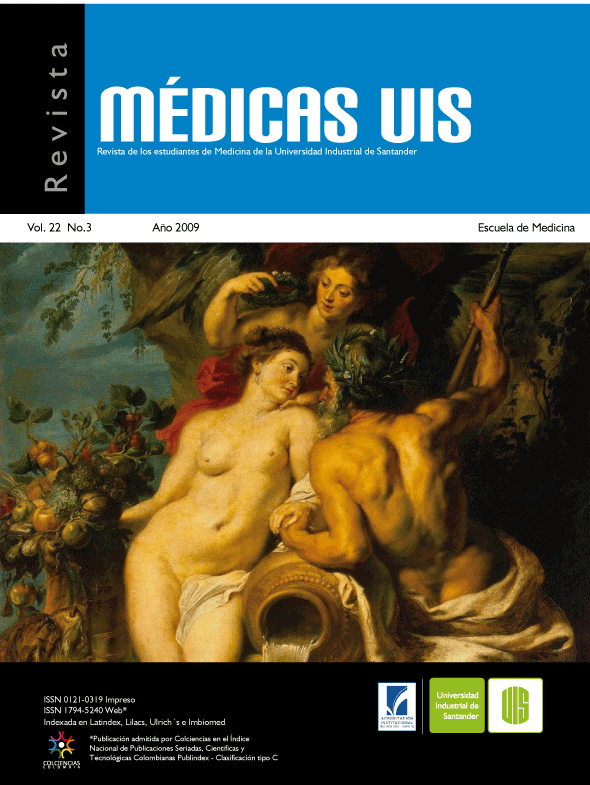Abstract
Toxic epidermal necrolysis is an infrequent pathology, accompanied of high mortality risk in concordance with extension of comprised skin characterized for blisters. Frequently these are present in respiratory, digestive and ocular mucous. An autopsy case is presented occurred in Hospital Universitario de Santander in october 2007 of toxic epidermal necrolysis secondary to treatment with phenytoin associated with valproic acid as anticonvulsivant therapy for messial hippocampal sclerosis. It pretends with this work show a review and to analyze related factors with this condition.
Key words: Toxic epidermal necrolysis. Stevens Johnson Syndrome. Phenytoin. Hippocampal sclerosis. Autopsy.
References
2.Chave TA, Mortimer NJ, Sladden MJ, Hall AP, Hutchinson PE. Toxic epidermal necrolysis: current evidence, practical management and future directions. Br J of Dermatol 2005;153:241–53.
3.Roujeau JC, Kelly JP, Naldi L, Rzany B, Stern RS, Anderson T, et al. Medication use and the risk of Stevens Johnson syndrome or toxic epidermal necrolysis. N Engl J Med. 1995:333(24):1600-7.
4.Mockenhaupt M, Schopf E. Epidemiology of drug induced severe skin reactions. Seminar in Cutaneous Medicine & Surgery. 1996;15(4):236-43.
5.Fauci AS, Kasper DL, Longo DL, Braunwald E, Hauser L, Jameson J, et al. Harrison’s principles of internal medicine. 17º ed. McGraw-Hill. 2008. Cutaneous Drug Reactions.
6.Kumar V, Abbas AK, Fausto N. Patología funcional y estructural. 7º edición. Elsevier. 2005. Madrid. Pp. 1750.
7.Nettina SM. Lippincott Manual of Nursing Practice. 8º ed. 2006. Dermatologic disorders.
8.Fiebach NH, Kern DE, Thomas PA, Ziegelstein RC. Principles of ambulatory medicine. Lippincott Williams & Wilkins. Philadelphia. 7º ed. 2007. Autoimmune Blistering Diseases, Photosensitive Eruptions, and Drug Eruptions.
9.Teo L, Tay YK, Liu TT, Kwok C. Stevens-Johnson syndrome and toxic epidermal necrolysis: efficacy of intravenous immunoglobulin and a review of treatment options. Singapore Med J. 2009;50(1):29-33.
10.Roujeau JC, Stern RS. Severe adverse cutaneous reactions to drugs. N Engl J Med 1994;331:1272.
11.Wehrli P, Viard I, Bullani R, Tschopp J, French LE. Death receptors in cutaneous biology and disease. J invest dermatol. 2000;115:141-8.
12.Arnold R, Seifert M, Asadullah K, Volk HD. Crosstalk between keratinocytes and T lymphocytes via Fas/Fas ligand interaction: modulation by cytokines. J Immunol. 1999;162(12):7140-7.
13.Gutierrez-Steil C, Wrone-Smith T, Sun X, Krueger JG, Coven T, Nickoloff BJ. Sunlight-induced basal cell carcinoma tumor cells and ultraviolet-B-irradiated psoriatic plaques express Fas ligand (CD95L). J Clin Invest. 1998;101(1):33-9.
14.Leverkus M, Yaar M, Gilchrest BA. Fas/Fas ligand interaction contributes to UV-induced apoptosis in human keratinocytes. Exp Cell Res. 1997 May 1;232(2):255-62.
15.Nassif A, Bensussan A, Boumsell L, Deniaud A, Moslehi H, Wolkenstein P. Toxic epidermal necrolysis: effector cells are drug-specific cytotoxic T cells. J Allergy Clin Immunol. 2004;114(5):1209–15.
16.Posadas SJ, Padial A, Torres MJ, et al. Delayed reactions to drugs show levels of perforin, granzyme B and Fas-L to be related to disease severity. J Allergy Clin Immunol. 2002;109:155-61.
17.Murata J, Abe R. Soluble Fas Ligand: Is It a Critical Mediator of Toxic Epidermal Necrolysis and Stevens–Johnson Syndrome? J Invest Dermat. 2007;127:744–5.
18.Stur K, Karlhofer FM, Stingl G. Soluble FAS ligand: a discriminating feature between drug-induced skin eruptions and viral exanthemas. J Invest Dermatol. 2007 Apr;127(4):802-7.
19.Mockenhaupt M, Viboud C, Dunant A, Naldi L, Halevy S, Bouwes Bavinck JN, et al. syndrome and toxic epidermal necrolysis: assessment of medication risks with emphasis on recently marketed drugs. The EuroSCAR-study. J Invest Dermatol. 2008 Jan;128(1):35-44.
20.Aguilar E, Pacheco A, Zambrano B. Necrólisis epidérmica tóxica. Síndrome de Lyell. Actas Dermosifiliogr 2000;91:541-51.
21.Nirken MH, High WA. Stevens-Johnson syndrome and toxic epidermal necrolysis: Clinical manifestations, pathogenesis, and diagnosis. Uptodate.
22.González A, Sanchez M, Garcia EY. Reacciones adversas a medicamentos: síndrome de stevens –johnson. InFÁRMAte 2007;2(14).
23.Roujeau JC, Stern RS. Severe adverse cutaneous reactions to drugs. N Engl J Med 1994;331(19):1272-85
24.Bastuji-Garin S, Rzany B, Stern RS, Shear NH, Naldi L, Roujeau JC Clinical classification of cases of toxic epidermal necrolysis, Stevens-Jonson syndrome, and erythema multiforme. Arch Dermatol 1993;129:92-6.
25.Ivan Cohen,Vincent Navarro, Caroline Le Duigou, Richard Miles. Mesial temporal lobe epilepsy: A pathological replay of developmental mechanisms? Biology of the Cell 2003;95:329-33.
26.Shangchen Xu, Qi Pang, Yuguang Liu, Wei Shang, Guode Zhai, Mingxu Ge. Neuronal apoptosis in the resected sclerotic hippocampus in patients with mesial temporal lobe epilepsy, Journal of Clinical Neuroscience 2007;14:835-40.
27.Bocti C, Diadori P, Lortie A, Mercier C, Bouthillier A, Carmant L. The pathological basis of temporal lobe epilepsy in childhood. Neurology 2003;60: 191-5.
28.Ho SS, Kuzniecky RI, Gilliam F, Faught E, Morawetz R. Temporal lobe developmental malformations and epilepsy: dual pathology and bilateral hippocampal abnormalities. Neurology 1998;50:748-54.
29.Fernández G, Effenberger O,Vinz B, Steinlein O, Elger CE, Döhring W, et al. Hippocampal malformation as a cause of familial febrile convulsions and subsequent hippocampal sclerosis. Neurology 1998;50:909-17.
30.Raksha MP, Marfatia YS. Clinical study of cutaneous drug eruptions in 200 patients. Indian J Dermatol Venereol Leprol. 2008 Jan-Feb;74(1):80.
31.Sharma VK, Sethuraman G, Minz A. Stevens Johnson syndrome, toxic epidermal necrolysis and SJS-TEN overlap: a retrospective study of causative drugs and clinical outcome. Indian J Dermatol Venereol Leprol. 2008 May-Jun;74(3):238-40.
32.Chatterjee S, Pal J, Biswas N. Nimesulide-induced hepatitis and toxic epidermal necrolysis. J Postgrad Med. 2008 Apr-Jun;54(2):150-1.
